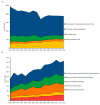Trends in Ultra-Processed Food Purchases from 1984 to 2016 in Mexican Households
- PMID: 30587779
- PMCID: PMC6356651
- DOI: 10.3390/nu11010045
Trends in Ultra-Processed Food Purchases from 1984 to 2016 in Mexican Households
Abstract
Global trade agreements have shaped the food system in ways that alter the availability, accessibility, affordability, and desirability of ready-to-eat foods. We assessed the time trends of ultra-processed foods purchases in Mexican households from 1984 to 2016. Cross-sectional data from 15 rounds of the National Income and Expenditure Survey (1984, 1989, 1992, 1994, 1996, 1998, 2000, 2002, 2004, 2006, 2008, 2010, 2012, 2014 and 2016) were analyzed. Food and beverage purchases collected in a daily record instrument (over seven days) were classified according to their degree of processing according to the NOVA food framework: (1) Unprocessed or minimally processed foods; (2) processed culinary ingredients; (3) processed foods; and (4) ultra-processed foods. From 1984 to 2016, the total daily energy purchased decreased from 2428.8 to 1875.4 kcal/Adult Equivalent/day, there was a decrease of unprocessed or minimally processed foods (from 69.8% to 61.4% kcal) and processed culinary ingredients (from 14.0% to 9.0% kcal), and an increase of processed foods (from 5.7% to 6.5% kcal) and ultra-processed foods (from 10.5% to 23.1% kcal). Given that ultra-processed foods purchases have doubled in the last three decades and unprocessed or minimally processed foods purchased have gradually declined, future strategies should promote the consumption of unprocessed or minimally processed foods, and discourage ultra-processed foods availability and accessibility in Mexico.
Keywords: Mexican households; purchases; trends; ultra-processed foods.
Conflict of interest statement
The authors declare no conflict of interest.
Figures



References
MeSH terms
LinkOut - more resources
Full Text Sources

